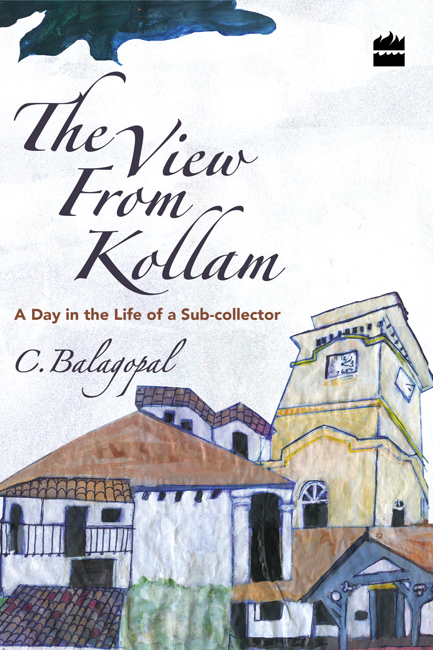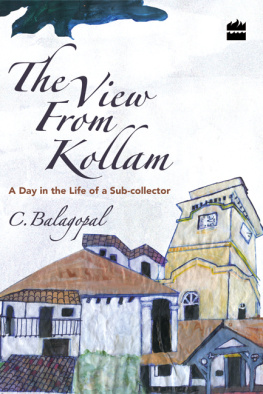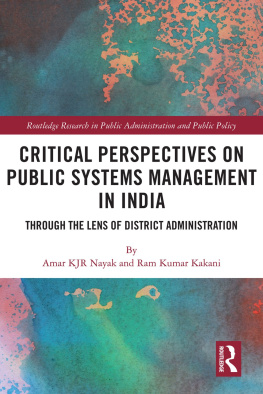
This book is dedicated to my parents Sarojini and Chandrasekharan Nair for their love and trust in me. I hope I have lived up to their impossibly high expectations, in terms of becoming a good person and useful member of society.
Contents

THE ANECDOTES NARRATED IN this collection dwell on the quotidian events that mark the work of a district official in Kerala, especially in Kollam (formerly called Quilon). To that extent, it is a continuation of the narrative from my earlier book On a Clear Day You Can See India . But the reader will soon find that while the work of the district official remains almost the same in Manipur and Kerala, there are glaring differences. These contrasts are less to do with language, customs, culture and history of the regions, considerable though these differences may be.
The warp and woof of which that narrative was woven used the thread that was spun and dyed in special circumstances. The looking-glass impression one would have got of the administration in Manipur, more farce than comedy, had less to do with the quality of staff and processesexecrable though both sometimes wereand more to do with the fact that politics and governance were heavily influenced by the colonial aspect, as much as the tribal and ethnic factors.
There was an undefinable air of otherness among non-local members of the administration, a sense of their not really being part of the machinery of governance, that they were merely playing a role, albeit reluctantly. There was a sense of being connected to other non-locals among the businessmen and traders there. This aspect was never far from the surface in any matter, howsoever trivial and quotidian it appeared. It surfaced in conversation and social transactions so casually that I often wondered whether someone in the room would take offence. But it appeared to be the most natural thing to do, almost a stating of something that was obvious.
In this collection, no such colonial flavour or otherness appears, because such a feeling does not exist in Kerala. While some amusement is derived by locals when a north Indian attempts to speak Malayalam, many cultural, historical, religious, and social factors come into play that have gone into the making of the merging pan-Indian identity. Differences are real, and often quite difficult to ignore, but they do not disturb the social fabric, and in fact serve to enrich the mosaic that modern Indian society is. Kerala can be cited as an excellent example of such a pan-Indian identity, having been since ancient times a crucible in which many different ethnicities and cultures and religions have been mixed. The modern identity of the Malayali has less to do with ethnic and religious factors and more to do with a distinctive lifestyle and culture and the unmistakable Malayali accent.
It is the deteriorating government processes and the consequent decline in effective governance that is the bedrock of all the anecdotes. Each story brings out yet another instance of a small but nevertheless important process of administration, observed only in name, but not in substance, robbing it of its purpose and meaning.
The story of the building of the mosque, for instance, highlights the high price a society often has to pay for procrastination, in terms of social tensions and stress, when timely action by a junior official would have ensured that justice was delivered without any dire social consequences. The tale of jamabandi underlines the problems resulting from not ensuring that the village accounts represent a true picture of the dues to government. Various layers of officialdom conduct this important exercise more as a ritual, affixing their signatures to reports that merely serve to push matters under the carpet, making the official records diverge even more from reality.
The story of the assessment of flood damage gives insights into how government statistics are collected and employed, pointing to the unreliable foundation on which major planning exercises conducted in distant capitals are built. This is again illustrated in the story about the cyclone shelters.
Another set of stories brings out the weaknesses in key government processes that hinder effective working. The saga of the modernization of the village office shows how ingenuity and clever networking were needed to ensure that a village office was provided with the bare necessities such as a table and chair.
The story of the sub-divisional magistrates (SDM) court brings out an important aspect that undercuts the very essence of governance, that is, the fact that government officials do not take their jobs and responsibilities with sufficient seriousness, leading a common man to think that most things are negotiable and flexible, when in fact they are not. This aspect is brought out amusingly in the anecdote of the discussion in the district collectors (DC) conference hall, where representatives of students unions were incensed when a young sub-collector gave them a lesson in the law and how it works.
The story of the disappearance of Sarasan, and the one about the missing young man who was feared to have been detained in a police station, both bring out the uneasy relationship between the police and the citizen. This relationship has been steadily vitiated by the political control over the police, espoused as an article of faith by one political formation, and as an expedient instrument by the other. Both, however, have had the unfortunate consequence that a citizen views the police as the henchmen of the political party in power, and not as guardians of the law. This has had a serious impact on the citizens social contract with government, leading him to be cynical about government actions.
A couple of stories deal with attempts by citizens to use these shortfalls in government processes to their own ends. One deals with two warring brothers, who seek ways of harassing one another using various provisions of the law and relying on the creaking government machinery to gain some leverage in terms of delays and expense. Another deals with the abuse of courtroom processes to prolong matters, forcing the other party to come to the negotiating table even though they may have a strong case.
It is the gradual wearing away of these quotidian processes, unnoticed or dismissed as trivial when they are noticed, that has led to the present situation where governance is seen as ineffective, where the rule of law is not seen to prevail, where only powerful mobilized groups are able to get their dues, and where the individual citizen feels helpless. This has happened through a thousand little failures happening every day, in every office and courtroom and police station across the nation. One only has to see the great changes wrought by wind and water over aeons to understand that the change may be gradual, but can still have a devastating impact on the original form and structure.
It is here that the experience of New York Mayor Rudy Guiliani, in turning around what was seen as a failing city administration to become one of the best administered cities, becomes relevant for modern Kerala. Guiliani is reported to have said that his strategy to turn things around was not based on taking on the big fish, mafia, or the powerful interests as he appeared to focus on the ordinary citizen. He diagnosed the problem of New York as being more one of ineffectual governance, with the citizen not caring about government, and hence of the laws. He, therefore, chose to start with the little offences such as parking violations, petty crime, and violence on the subway and on the streets. He chose a policy of zero tolerance, where every violator would be punished. And it worked. The citizens of New York started to take notice of a government that meant business, because they now began to feel the heat every day. The effects were dramatic. Crime fell steeply in what was at one time perceived to be the most unsafe city in the US. Very soon, the streets of New York were reported to be safer than those of other major cities in the world, and in fact most other cities in the US.
Next page











